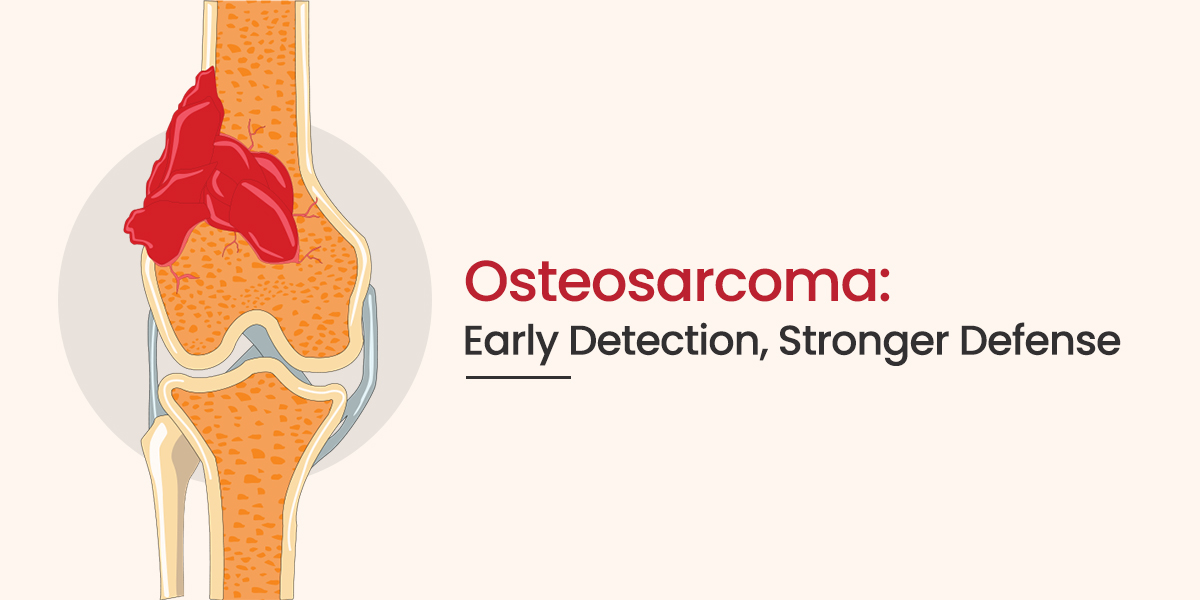What is Osteosarcoma? Meaning, Causes, and Risk Factors

Osteosarcoma is a rare and aggressive bone tumor that typically originates in the cells responsible for forming new bone. It most frequently affects the long bones of the arms and legs, particularly near the knee. While it can occur at any age, it is more common in teenagers and young adults experiencing growth spurts.
Osteosarcoma Meaning
- Definition: It is a cancerous tumor that arises from osteoblasts, cells responsible for bone formation.
- Nature of the disease: It develops quickly and can spread (metastasize) to other sites in the body, usually the lungs.
- Occurrence:
Primary osteosarcoma arises without a pre-existing condition.
Secondary osteosarcoma can arise after previous exposure to radiation or some bone illness.
Causes of Osteosarcoma
The exact etiology is not known, but some genetic and environmental factors have been associated with the disease. The following are possible causes:
- Genetic Changes: Changes in tumor suppressor genes such as RB1 and TP53.
- Rapid Bone Development: Seen during adolescence, which may account for the increased risk in teenagers.
- Radiation Exposure: Prior radiation therapy for another tumor increases the risk.
- Inherited Conditions: Such as Li-Fraumeni syndrome, Rothmund-Thomson syndrome, or familial retinoblastoma.
Osteosarcoma Risk Factors
Key risk factors that can raise the prospect of developing this cancerous disease are:
- Age and growth phase: Most frequently between 10 and 20 years old.
- Sex: Slightly higher in men.
- Height: Tall teenagers may be at increased risk.
- Prior radiation therapy: Particularly at high doses.
- Certain bone diseases: For e.g., Paget’s disease of bone.
Osteosarcoma Symptoms
It is important to detect cancers early to treat them successfully. Some of the symptoms of Osteosarcoma are:
- Persistent bone pain that occurs at night or increases with activity.
- Swelling or a lump over the involved bone.
- Decreased movement or stiffness of the joint.
- Unexplained fractures due to weak bone.
- Limping or inability to put weight on the affected bone.
Note: The above symptoms are not specific to osteosarcoma and may be due to other conditions. Yet, persistent or increasing pain should always be investigated by a physician.
Diagnosis and Radiology of Osteosarcoma
Diagnosis consists of a combination of clinical examination, imaging, and biopsy:
- X-rays: Often the first imaging test, they can reveal bone destruction or abnormal bone formation.
- MRI scans: Give a clear picture of the size of the tumor and its extent of involvement with surrounding tissues.
- CT scans: Especially helpful in identifying lung metastases.
- Bone scans: To check if it’s spread to other bones.
- Biopsy: Verifies the diagnosis by examining the tissue under the microscope.
Osteosarcoma radiology is essential not only for the detection but also for planning the surgery and monitoring treatment response.
Osteosarcoma Treatment
The treatment of Osteosarcoma is most often multidisciplinary, involving oncologists, orthopedic surgeons, and radiologists. Common approaches include:
1. Chemotherapy
- Administered before surgery (neoadjuvant) to reduce the size of the tumor.
- Given after surgery (adjuvant) to destroy remaining cancer cells.
2. Surgery
- Limb-sparing surgery: Removes the tumor while preserving as much of the limb as possible.
- Amputation: Required in some instances when the tumor cannot be safely removed.
3. Radiation therapy
- Less commonly used for osteosarcoma, but it can be required in certain situations.
4. Targeted therapy & immunotherapy
- Emerging options under clinical research.
Prognosis
Five-year survival rate: Around 77% for localized osteosarcoma according to the American Cancer Society.
Prognosis depends on:
- Tumor location and size.
- Presence of metastases at diagnosis.
- Response to chemotherapy.
Prevention and Early Detection
Currently, there is no guaranteed way to prevent osteosarcoma. However:
- Regular check-ups after previous cancer treatments are important.
- Prompt evaluation of persistent bone pain in young people can lead to early diagnosis.
- Awareness in high-risk families with identified genetic syndromes.
Quick Reference Table
| Aspect | Details |
|---|---|
| Common Age Group | 10-20 years |
| Common Sites | Femur, tibia, humerus |
| Key Symptoms of Osteosarcoma | Bone pain, swelling, fractures |
| Main Diagnostic Tools | X-ray, MRI, CT, biopsy |
| Osteosarcoma Treatments | Chemotherapy, surgery, targeted therapy |
| Survival Rate (Localised) | 77% |
Choosing the Proper Treatment Facility
When treating a high-risk and aggressive cancer like osteosarcoma, it is important to get care from a professional facility with advanced diagnostics and a multidisciplinary team. If you reside in Uttar Pradesh, visit Regency Healthcare, the best cancer hospital in Kanpur, for professional cancer care.
Final Thoughts
Osteosarcoma is a challenging disease that requires early detection and a coordinated approach. Understanding its cause, risk factors, and treatment helps patients and their families make timely decisions. Advances in research and development in osteosarcoma radiology and targeted therapies provide hope for improved results in the future.
Also Read: How Immunotherapy Works to Fight Cancer: A Complete Guide

 Call-an-Ambulance
Call-an-Ambulance



